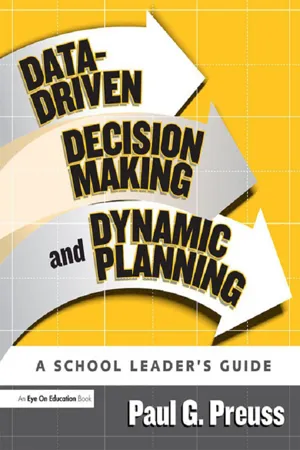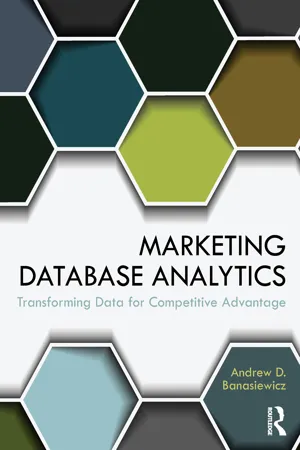Data-driven Decisions
Data-driven decisions refer to the process of making informed and strategic choices based on the analysis of relevant data. This approach involves using quantitative and qualitative data to identify trends, patterns, and insights that can guide decision-making. By leveraging data, businesses can enhance their operational efficiency, improve customer experiences, and gain a competitive edge in the market.
8 Key excerpts on "Data-driven Decisions"
- eBook - ePub
- Paul Preuss(Author)
- 2013(Publication Date)
- Routledge(Publisher)
...Those eager to conduct further research on this topic will find ample additional materials to study. Data-driven decision making is the process of making choices based on appropriate analysis of relevant information. School district decision makers are using technology and professional expertise to improve instruction and operations. http://www.3d2know.org/ The National Education Technology Plan, Toward A New Golden Age in American Education calls upon states, districts, and schools to establish a plan to integrate data systems; use data from both administrative and instructional systems to understand relationships; ensure interoperability; and use assessment results to inform instruction. www.NationalEdTechPlan.org This same report provides a technology framework for No Child Left Behind success that includes the following ten components: The purpose of this technology framework is to break down the walls of isolated data sets by aggregation of data into large scale data warehouses, which can then be queried for the purpose of reporting out answers to specific questions, which, in turn, will inform the instructional decision-making process thereby enabling continuous school improvement. Learning Point Associates (www.ncrel.org) (The North Central Regional Educational Lab) has a fine site with numerous resources for the use of data in education, including a 28-page white paper that is free for the asking or may be downloaded quickly. The closest I could come to a finding a specific definition for data-driven decision making, however, is found in the description of the four part school improvement cycle (Plan, Do, Study, Act) found at the bottom ofpage 3 and reproduced here:“Data are the key to continuous improvement. When you “plan” you must use data to provide insight and focus for your goals. Data patterns reveal strengths and weaknesses in the system and provide excellent direction. When you “do,” you collect data that will tell you the impact of your strategies...
- Cris Doloc(Author)
- 2019(Publication Date)
- Wiley(Publisher)
...CHAPTER 2 The Role of Data in Trading and Investing “The secret to being successful from a trading perspective is to have an indefatigable, an undying and unquenchable thirst for information and knowledge.” – Paul Tudor Jones, famous investor, hedge fund manager 2.1 THE DATA-DRIVEN DECISION-MAKING PARADIGM Due to an extraordinary wave of technological innovation our civilization has reached a critical phase in its evolution. Because our ability to collect and analyze massive amounts of data, conditions have been created for the development and implementation of a new paradigm to assist the decision-making process: data-driven decision-making. This process is driven by several factors: VALUE : Due to the high costs associated with the process of collecting, cleansing, and hosting data, as well as the potential future business value, organizations are considering their data as a strategic asset. CULTURE : Global competition forces corporations to adhere to the new data culture, where high-quality data, broad access, and data literacy are the baseline requirements. RELIABILITY : Ultimately, the decision-making process needs to become more transparent, reproducible, and the desired business outcomes need to be more forecast-able. Data as the single source of truth is becoming a central theme of this new paradigm. Having access to what one calls a single source of truth will lend higher value to the end user of any service or product, as it does for the decision-makers. Efficiency will be enhanced by spending less time in gathering data from across fragmented data stores, yet allocating more time to data analysis and the extraction of actionable knowledge. By providing a richer context about the problem domain, the users will be better positioned to leverage their access to data and find actionable insights. Traditionally the decision-making process was driven by individuals who could override signals coming from data at any point in time...
- Simone Gressel, David J. Pauleen, Nazim Taskin(Authors)
- 2020(Publication Date)
- SAGE Publications Ltd(Publisher)
...Understanding the way data and analytics can support you in your decision-making will be immensely helpful once you become a manager. If you are on the data analytics side of things, then understanding the decision-making process and the way human judgment and analytics can work together will help you to understand what the business side of the organization needs and how and when to provide it. Management decision-making types, self-assessment exercises and ways to improve both judgment and analytics KSAs are discussed in depth in Chapter 6. Organizational Culture and Capabilities We have also seen in this chapter and throughout the book some discussion of how organizational culture and data analytics maturity of the organization can have an impact on the use of data in the decision-making process: for example, companies like Google and Amazon, that were founded in the Dot-Com age, have developed sophisticated data-driven cultures. In our research and the literature, we see clear evidence that data-driven decision-making requires a readiness on the part of organizations for big data and analytics-driven decisions (Jagadish et al., 2014; Gupta and George, 2016; Shah et al., 2017). Managers reporting high-data decisions work in a data-ready environment and because of this tend to experience successful decision outcomes. Although strategic decisions usually require high levels of human judgment, an organization’s level of maturity will enable managers to benefit from sophisticated and tested data analytics methods, which already incorporate individual and organizational expertise. In such environments, data and analytical approaches prove more reliable and often lead to better outcomes than decisions based on judgment (Khatri and Ng, 2000; Dijksterhuis and Nordgren, 2006)...
- eBook - ePub
Marketing Database Analytics
Transforming Data for Competitive Advantage
- Andrew D. Banasiewicz(Author)
- 2013(Publication Date)
- Routledge(Publisher)
...developments are to a large degree responsible for the growing importance of unique (to a given organization), fact-based knowledge in building and sustaining competitive advantage. In a sense, all organizations are now in the information business, to the degree to which their competitive well-being has increasingly grown dependent on the access to timely and accurate decision-guiding insights. Stated differently, knowledge surrounding the key decisions, such as product design (i.e., what is the most desirable bundling of product attributes?), promotional mix allocation (i.e., how should the finite promotional dollars be allocated across the available promotional alternatives to deliver the highest incremental benefit?) or the customer acquisition and retention strategy (i.e., what are the most cost-effective tools/tactics?) is now among the most pronounced determinant of firms’ success. In a recent, insightful look at the impact that the persistent and well-thought-out data analysis—defined as reliable conversion of raw data into competitively advantageous knowledge—can have on organizations’ long-term success, Thomas Davenport delineated a number of key factors characterizing information-driven organizations. 19 These include the widespread use of modeling and optimization, enterprise-wide deployment of data-derived insights and solid support from the top echelons of management. Of those, the widespread use of modeling and optimization comprises the general set of skills needed to translate the mounds of often dissimilar raw data into useful information. As detailed by Davenport, the quality of the resultant analyses requires the coming together of three key components: the right focus, the right people and the right technology...
- eBook - ePub
Be Data Literate
The Data Literacy Skills Everyone Needs To Succeed
- Jordan Morrow(Author)
- 2021(Publication Date)
- Kogan Page(Publisher)
...This is on purpose, but I do concede that in most cases data driven is used in the world today. The term ‘data driven’ really gained steam in the late 2010s and into 2020, and especially moved forward with the onslaught of the worldwide COVID-19 pandemic. To be data driven means many things to many people, but ultimately it means data is strongly being used as an asset for an individual or organization. Think of it as a marathon runner using a plan to drive a strategy for a successful marathon. This is what data driven or data informed means. It means that data is helping to drive decisions and the business forward. The reason I use the term data informed over data driven is that with the term data driven one can make the mistake in thinking that the data is truly driving everything. Data informed means the data was used to help make the decision, but is combined with other things, like the human element. This distinction matters as it is powerful. To help us understand data informed decisions and their combination with data literacy, we will be digging into our entire bag of tricks of data literacy. We will start by defining the framework and its power to drive decision-making. We will be looking at the data informed decision-making framework from what may seem like all possible angles: the four characteristics of the definition of data literacy, the four levels of analytics, speaking the language of data, the three Cs of data literacy, and probably more angles. For us to get started here, we need to know the steps of the data informed decision-making framework. Steps of the data informed decision-making framework The data informed decision-making framework we are employing for this book has six steps. Please note, there are different frameworks that exist in the world for making a decision, but for a strong decision-making framework to be deployed and used correctly, these six steps need to be incorporated in some way, shape, or form...
- eBook - ePub
Analytics for Managers
With Excel
- Peter C. Bell, Gregory S. Zaric(Authors)
- 2013(Publication Date)
- Routledge(Publisher)
...Chapter 4 DATA-DRIVEN DECISION MAKING DOI: 10.4324/9780203105818-4 Barry Beracha, the former chief executive of the Sara Lee Bakery Group, has been quoted as emphasizing the importance of data as an input to management decisions: “In God we trust. All others bring data.” 1 1 This quotation appears in Tom Davenport, Competing on Analytics: The New Science of Winning by Jeanne G. Harris, Harvard Business Press Books, 2007, but is more commonly attributed to W. Edwards Demming, the founder of modern quality control. Data can provide a factual base for decisions: some firms say that they are “fact-based decision makers.” Data, however, starts out as just numbers and it must be processed into information that is useful to the decision maker. One framework for extracting useful information from data is that provided by classical statistics. This framework provides a way of visualizing and interpreting data that raises many important questions about the data and the information derived from it. In this chapter, we provide an introduction to several concepts from statistics that are used to visualize and interpret data. But first, we define statistics: Statistics is concerned with making inferences about a population based on information contained in a sample. Populations and Samples The first important statistical concept is the distinction between a population and a sample. A manager will frequently wish to understand the activities or preferences of a certain group (the population), but, due to resource constraints, it is often not possible to gather information from all possible sources. Thus, a subset, known as a sample, is used. Large groups or populations may be sampled and the sample data summarized in a statistic and used to draw conclusions or inferences about the population. Patterns may be revealed and conclusions arrived at with confidence. More formally, we say that: The population is the complete set of elements possessing measures of interest (i.e...
- eBook - ePub
Decision Making in Educational Leadership
Principles, Policies, and Practices
- Stephanie Chitpin, Colin W. Evers, Stephanie Chitpin, Colin W. Evers(Authors)
- 2014(Publication Date)
- Routledge(Publisher)
...Part I Data-Driven Decision Making 1 The Changing Dynamics of Educational Judgment and Decision Making in a Data-Driven World Andy Hargreaves, Beth Morton, Henry Braun, and Alex M. Gurn Introduction Among the many changes that affect us all in the first decades of the 21st century is the presence and impact of digital data. We use data to count our steps and our calories. Data track and target our online shopping preferences and customer purchasing habits. Data measure performance in business, sport, and health services, comparing individuals, units, and organizations against each other in areas as diverse as reputation indicators, infection levels, and injury rates. Facial recognition software can help us pick out a potential terrorist in a crowd, and data systems have also been used to trawl billions of phone calls and keyboard strokes among ordinary people across the world “just in case” they may have some use in the future. The use of data in the modern age can be superficial or sinister, helpful or harmful, a way to focus on core purposes or a device to distract people’s attention from them. In Big Data, Mayer-Schönberger and Cukier (2013) describe many of the ways that data enter into and also enhance our lives. Big Data, they say, are about “the ability of society to harness information in novel ways to produce useful insights or goods and services of significant value” (p. 2). They point to how the growing capacity to analyze vast volumes of data has made it possible to predict the spread of flu pandemics, to pinpoint the buildings most likely to be overcrowded fire hazards, and to use complex algorithms to provide just-in-time feedback in response to people’s progress in their online learning. But after their enthusiastic advocacy for Big Data, the authors then advise against turning to data for the answer to all our problems...
- Thomas A. Cook(Author)
- 2018(Publication Date)
- CRC Press(Publisher)
...A company that is completely risk adverse will grow more slowly as compared to one that is typically willing to accept certain levels of risk. Appreciate that in the decision-making process, risk is a very important component of the thought process. Additionally, that consistent and defined steps are managed to create a pathway to better decision making. That is the heart of this chapter … how do we go about making better business decisions? BETTER DECISION MAKING: QUALITATIVE VERSUS QUANTITATIVE The decision-making effectiveness of a business executive, manager, and leader will be a defining character trait evidencing strong capabilities and wherewithal. You will be faced with having to make business decisions every day of which many will impact the success of the organization. Two key factors in decision-making effectiveness is the use of two measurement systems known generically as qualitative and quantitative analysis. Understanding how to utilize these two methods of analysis in decision-making will lead to more consistent, well thought out, and better decisions. Executives would be in a much better position in achievement when they know how to work both qualitative and quantitative analysis options. DEFINITIONS QUALITATIVE Qualitative is associated with the subjective quality of a thing or phenomenon, such as feel, taste, expertise, image, leadership, and reputation. Qualitative aspects are abstract: they either do not require measurement or cannot be measured because the reality they represent can only be approximated...







